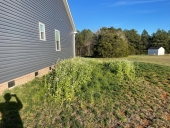




 3
3




Invasive plants are Earth's way of insisting we notice her medicines. Stephen Herrod Buhner
Everyone learns what works by learning what doesn't work. Stephen Herrod Buhner

 4
4




 1
1




Eino Kenttä wrote:-I don't know about UV protection. The problem is that the only way to use plants to protect against it, is to create shade. Maybe you can see if there's a pattern as to which plants get burnt, and which manage, and then focus on growing the ones that manage?




I do Celtic, fantasy, folk and shanty singing at Renaissance faires, fantasy festivals, pirate campouts, and other events in OR and WA, USA.
RionaTheSinger on youtube

 2
2




Riona Abhainn wrote:I think kiwi can only grow in zones 8 and higher?
 1
1




Riona Abhainn wrote:I think kiwi can only grow in zones 8 and higher?




Eino Kenttä wrote:You can grow one of the hardy species, Actinidia arguta or A. kolomikta. The kolomikta grows and fruits just fine in north-ish Sweden (supposedly USDA zone 5, but with quite long winters). The fruits are way smaller than "ordinary" kiwi, but taste about the same, if not better, and can be eaten whole, skin and all. The skin is not hairy, unlike ordinary kiwi.
Eino Kenttä wrote:As for kiwi casting too deep a shade, I've heard someone say that you can't over-prune a kiwi vine. So maybe you could grow it and continuously prune it to the right density, and use the pruned material as mulch? Chop and drop, more or less?

 2
2




Zoltán Korbel wrote: Do you happen to have experience based knowledge of how fast Kiwi grows in a specific zone or climate?
I also need to find out how close I can plant other plants to the trunk of the Kiwi plant. I heard it's not a good companion.

| I agree. Here's the link: http://stoves2.com |






